Buddhism: Tibetan: Contemporary Masters & Teachings
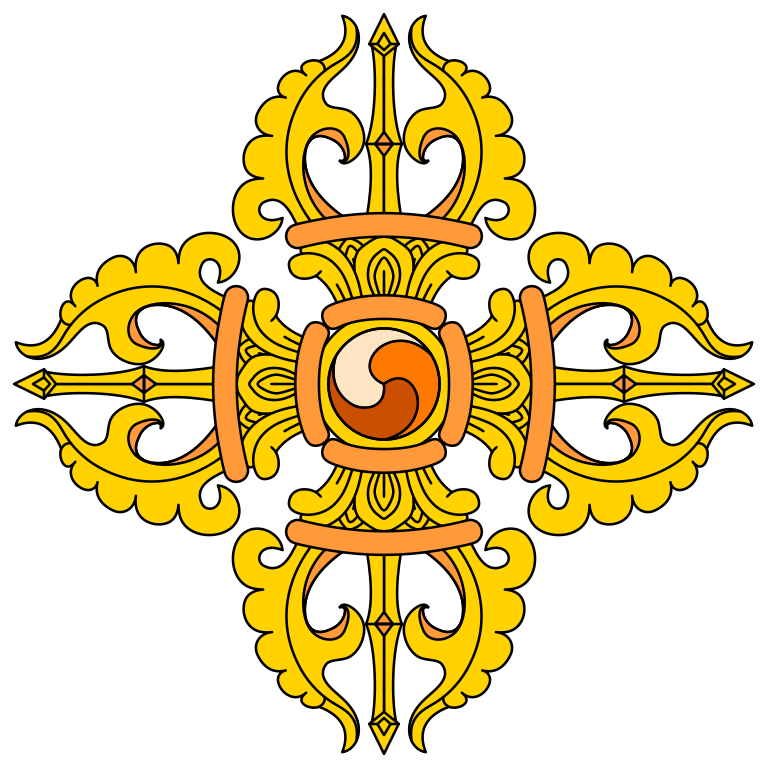
Tibetan Buddhism: Contemporary Masters & Teachings
Vajra logo: Source: Wikimedia Commons | Author: Madboy74 | License: Creative Commons Attribution-ShareAlike 1.0 Generic.
On this page you can find the best resources for exploring scholarly perspectives on the most important contemporary masters and teachings in the Tibetan tradition of Buddhism. Each book listed below is linked to WorldCat, where you can discover library holdings for that item in your region. Resources within the gallery box are arranged from the newest to the oldest publications, left to right. The area below the gallery highlights a few recent or especially notable works selected from the gallery above.

Above: A novice sweeps the stairs outside Gandan Khiid, a Tibetan Buddhist monastery in Ulaanbaatar, Mongolia.
Image source: Flickr. Image author: The Wandering Angel. Image license: Creative Commons Attribution 2.0 Generic.
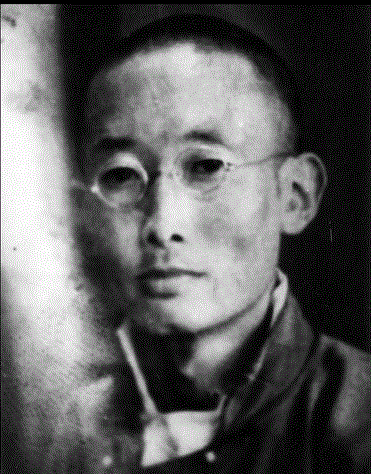 Gendün Chöpel (1903 – 1951)
Gendün Chöpel (1903 – 1951)
Gendün Chöpel was a Tibetan scholar, thinker, writer, poet, linguist, and artist. He was born in 1903 in Shompongshe, Rebkong, Amdo. He was a creative and controversial figure and he is considered by many to have been one of the most important Tibetan intellectuals of the twentieth century. He is best known for a collection of essays entitled The Madman's Middle Way and for the travelogue Grains of Gold: Tales of a Cosmopolitan Pilgrimage, written during his time in India and Sri Lanka in between 1934 and 1946. These writings were critical of modern Hinduism, Christianity, and British imperialism. While condemning places and events like the Black Hole of Calcutta and the Goa Inquisition, he also praised certain British colonial practices like the abolition of sati. Chöpel completed The Passion Book in 1939, a collection of poems written in Tibetan verse, which has become the most famous work of erotica in the canon of Tibetan Buddhism. He used two sources for his work - classical Sanskrit writing and his own experiences.
Left: Gendün Chöpel, photographed in India in 1936. Text source: Wikipedia (edited). This version of Wikipedia content is published here under a Creative Commons Attribution-ShareAlike 3.0 Unported License. Image source: Wikimedia Commons. Image author: Unknown. Image license: Public domain. All books in the gallery immediately below are by Gendün Chöpel unless otherwise noted.
 Dudjom Rinpoche (1904 – 1987)
Dudjom Rinpoche (1904 – 1987)
Dudjom Jigdral Yeshe Dorje was the second Dudjom Rinpoche. He was recognized as a direct rebirth of Dudjom Lingpa (1835–1904) and was also later appointed the first supreme head of the Nyingma lineage of Tibetan Buddhism by the fourteenth Dalai Lama and the Central Tibetan Administration. Dudjom Rinpoche was known for preserving many of the historic terma teachings and practice lineages that were at risk of being destroyed. He is described by followers as having been an exceptional scholar in various fields, including sutra, tantra, prose literature, poetry, and history, and he wrote a history of the teachings of the Nyingma lineages encompassing twenty-five volumes, with the intent of creating an authoritative account. He also helped transfer many texts out of Tibet, preserving them from destruction after the invasion of Tibet and the Cultural Revolution. After he went into exile, he organized the building of monasteries, and teaching and retreat centers, in India, Nepal, Bhutan, and other countries. Both of the present Dalai Lama's teachers in the Dzogchen tradition were disciples of this, the second Dudjom Rinpoche.
Left: Dudjom Rinpoche (seated) with Prince Paljor Namgyal (right) and Maharani Kunzang Dechen Tshomo Namgyal (left), photographed in Tibet some time before 1941. Text source: Wikipedia (edited). This version of Wikipedia content is published here under a Creative Commons Attribution-ShareAlike 3.0 Unported License. Image source: Wikimedia Commons. Image author: Unknown. Image license: Public domain.
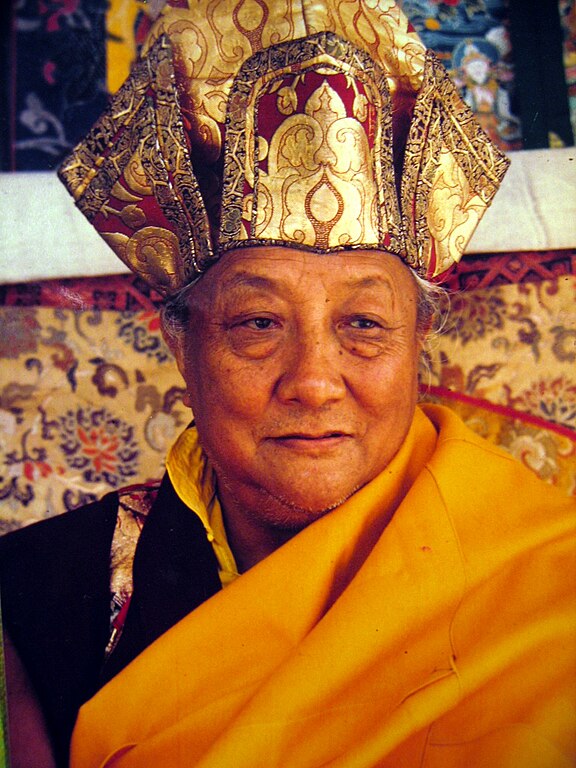 Dilgo Khyentse (ca. 1910 – 1991)
Dilgo Khyentse (ca. 1910 – 1991)
Dilgo Khyentse Rinpoche was a Vajrayana master, scholar, poet, teacher, and head of the Nyingma school of Tibetan Buddhism from 1987 to 1991. As the primary custodian of the teachings of Jamyang Khyentse Wangpo, Dilgo Khyentse was the de facto custodian of the vast majority of Tibetan Buddhist teachings. He was born in 1910 in the Denhok Valley at Kham Derge, Eastern Tibet. When he was seven years old, he was publicly recognized as one of the reincarnations of Jamyang Khyentse Wangpo at Shechen, one of the six principal monasteries of the Nyingmapa school. During the next few years Khyentse received full schooling from various tutors, in addition to training in meditation and tantra. After he completed what is known as the Preliminary Practices (Ngöndro), Khyentse spent most of the next 13 years in silent retreat in remote hermitages and caves near his birthplace. After completing his retreat at the age of 28 and having studied extensively under Khyentse Chokyi Lodro, Khyentse requested to spend the rest of his life in solitary meditation. Lodro, however, replied, "The time has come for you to teach and transmit to others the countless precious teachings you have received." In the 1950s, as rebellions broke out in response to the imposition of Chinese Communist rule, Khyentse and his family escaped to central Tibet, leaving behind his library of dharma books and most of his own writings. Then, in 1959, after the Dalai Lama left Tibet, Khyentse, his family, and a few disciples also departed, and headed for Bhutan with an invitation from the Bhutanese royal family. Later, he began giving teachings all over the Himalayas, India, Southeast Asia and the West. After founding the Shechen Tennyi Dargyeling Monastery in Nepal in 1980, he taught hundreds of other lamas, disciples, and students from around the world. Over this same period, and until his death in 1991, Khyentse was involved in the publication of more than 300 volumes of Tibetan Buddhist teachings.
Left: A portrait of Dilgo Khyentse in full priestly regalia. Text source: Wikipedia (edited). This version of Wikipedia content is published here under a Creative Commons Attribution-ShareAlike 3.0 Unported License. Image source: Wikimedia Commons. Image author: Sherab. Image license: Public domain. All books in the gallery immediately below are by Khyentse unless otherwise noted.
Thinley Norbu (1931 – 2011)
Kyabjé Dungse Thinley Norbu Rinpoche was a major modern teacher in the Nyingma lineage of Tibetan Buddhism, and patron of the Vajrayana Foundation. The eldest son of Dudjom Rinpoche, the former head of the Nyingma lineages, Norbu was born in Lhasa in 1931. His association with the Dudjom Lineage is a long one: he is held to be the incarnation of Tulku Drime Oser, who was one of seven sons of Dudjom Lingpa (1835-1904). He also was considered to be an emanation of Longchen Rabjam, the great 14th-century Nyingma scholar and siddha who composed the Seven Treasuries. In the mid 1950s, Thinley Norbu left Tibet at the onset of the Chinese invasion of Tibet. Having fled his homeland, he spent some time in Bhutan, where his sons were born. There he served as the chief architect of the Thimphu Memorial Chorten, built in 1974 under the guidance of his father, to honor the memory of the third King of Bhutan, Jigme Dorji Wangchuck (1928–72). Norbu first came to the United States of America in 1976 to seek medical treatment, before permanently settling in the US in the early 1980s. In the late 1980s and early 1990s, after spending a number of years in New York City, Thinley Norbu sought out a quiet place for practice in the countryside of the east coast of the United States. After a long search, in 1991 he chose some land in the rolling hills of upstate New York and named it Kunzang Gatshal, Always Noble Joyful Park. For the next twenty years, Kunzang Gatshal served as Thinley Norbu's primary residence and focal point of dharma activity. In the mid-1990s, Thinley Norbu built a temple on the land, personally directing all aspects of the construction and design until every statue and offering had been set. At around the same time, he founded a school for young children to learn pure dharma tradition and practice, White Lotus School, which he looked after with particular care. The rest of his time was spent writing more than a dozen books, many of which were published posthumously and several that still remain unpublished. Norbu's books have become quite popular in the west, but in contrast to many other Tibetan teachers he did not seek publicity or large numbers of students.
Text source: Wikipedia (edited). This version of Wikipedia content is published here under a Creative Commons Attribution-ShareAlike 3.0 Unported License. All books in the gallery immediately below are by Thinley Norbu unless otherwise noted.
Kelsang Gyatso (born 1931)
A Buddhist monk, meditation teacher, scholar, and author. He is the founder and former spiritual director of the New Kadampa Tradition-International Kadampa Buddhist Union (NKT-IKBU), an "entirely independent" Modern Buddhist order that presents itself to be a tradition based on the teachings of the Gelugpa tradition of Tibetan Buddhism, which has grown to become a global Buddhist organisation and currently claims to have 1200 centers and branches in 40 countries around the world. Kelsang Gyatso is known among students of Buddhism for establishing the NKT and for his books which outline what he sees as key aspects of the Gelugpa tradition. He has become known for elevating the status of Dorje Shugden, by claiming Shugden's appearance is enlightened. Kelsang Gyatso founded the New Kadampa Tradition "to bring pure Buddhist teachings to the west," where he would train equally four types of teacher: monks, nuns, lay men and lay women. NKT-IKBU Dharma Centres are mixed communities of lay and ordained practitioners who are all on the same teaching programs. He also promotes the development of local teachers in their own language. This is a departure from most Tibetan Buddhist Centres where monastics take precedence over lay people, monks take precedence over nuns, and Tibetans take precedence over Westerners.
Text source: Wikipedia (edited). This version of Wikipedia content is published here under a Creative Commons Attribution-ShareAlike 3.0 Unported License. All books in the gallery immediately below are by Kelsang Gyatso unless otherwise noted.
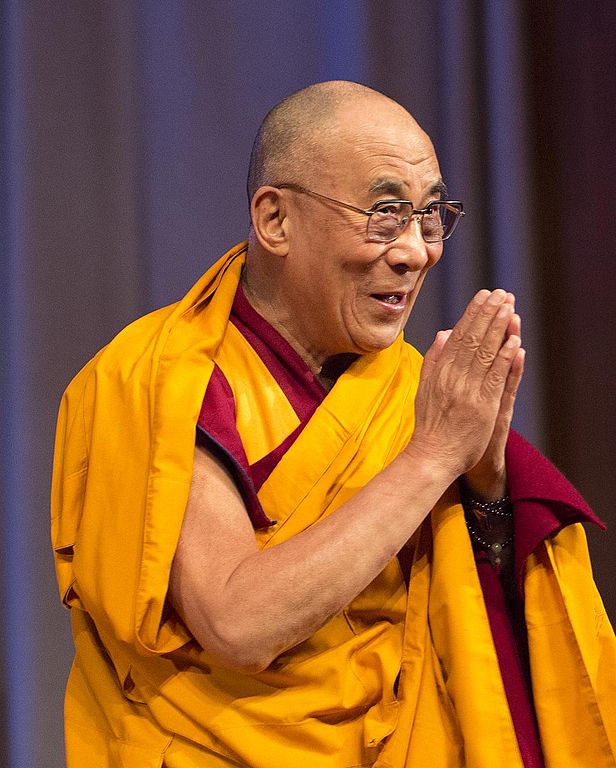 H.H. Tenzin Gyatso, the 14th Dalai Lama (born 1935)
H.H. Tenzin Gyatso, the 14th Dalai Lama (born 1935)
His Holiness Tenzin Gyatso, the 14th Dalai Lama (born Lhamo Thondup) is the current Dalai Lama. Dalai Lamas are important monks of the Gelug school. From the time of the 5th Dalai Lama to 1959, the central government of Tibet, the Ganden Phodrang, invested the position of Dalai Lama with temporal duties. The 14th Dalai Lama was born in Taktser, Amdo, Tibet. He was selected as the tulku of the 13th Dalai Lama in 1937 and formally recognized as the 14th Dalai Lama in a public declaration near the town of Bumchen in 1939. His enthronement ceremony as the Dalai Lama was held in Lhasa on 22 February 1940 and he eventually assumed full temporal (political) duties on 17 November 1950, at the age of 15, after the People's Republic of China's incorporation of Tibet. The Gelug school's government administered an area roughly corresponding to the Tibet Autonomous Region, just as the nascent PRC wished to assert control over it. During the 1959 Tibetan uprising, the Dalai Lama fled to India, where he currently lives as a refugee. He has traveled the world and has spoken about the welfare of Tibetans, environment, economics, women's rights, non-violence, interfaith dialogue, physics, astronomy, Buddhism and science, cognitive neuroscience, reproductive health, and sexuality, along with various topics of Mahayana and Vajrayana Buddhist teachings. A recipient of the Nobel Peace Prize in 1989, Time magazine named him one of the "Children of Mahatma Gandhi" and the latter's spiritual heir to nonviolence.
Left: The Dalai Lama, photographed speaking at MIT in October 2012. Text source: Wikipedia (edited). This version of Wikipedia content is published here under a Creative Commons Attribution-ShareAlike 3.0 Unported License. Image source: Wikimedia Commons. Image author: Christopher Michel. Image license: Creative Commons Attribution 2.0 Generic. All books in the gallery immediately below are by the Dalai Lama unless otherwise noted.

Above: Statues of deities and bodhisattvas carefully tucked away on the shelves at Gandan Khiid, a Tibetan Buddhist monastery in Ulaanbaatar, Mongolia.
Image source: Flickr. Image author: The Wandering Angel. Image license: Creative Commons Attribution 2.0 Generic.
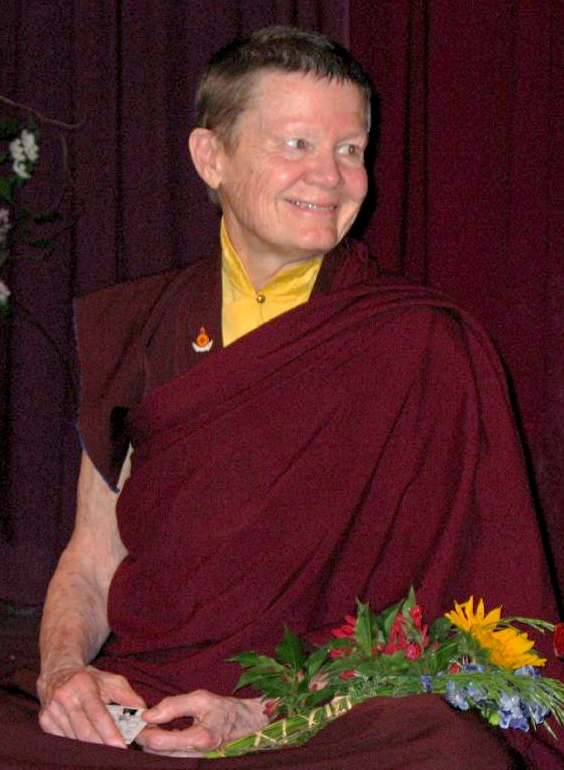 Pema Chödrön (born 1936)
Pema Chödrön (born 1936)
Pema Chödrön is an American Tibetan Buddhist. She is an ordained nun, acharya, and disciple of Chögyam Trungpa. Chödrön has written several dozen books and audiobooks, and is principal teacher at Gampo Abbey in Nova Scotia, Canada. Chödrön was born Deirdre Blomfield-Brown in 1936 in New York City. She attended Miss Porter's School in Farmington, Connecticut and grew up on a New Jersey farm with an older brother and sister. She obtained a bachelor's degree in English literature from Sarah Lawrence College and a master's in elementary education from the University of California, Berkeley. Chödrön began studying with Lama Chime Rinpoche during frequent trips to London over a period of several years, and continued her studies with Chögyam Trungpa in San Francisco. In 1974, she became a novice Buddhist nun under Rangjung Rigpe Dorje, the sixteenth Gyalwa Karmapa. In Hong Kong in 1981 she became the first American in the Vajrayana tradition to become a fully ordained nun or bhikṣuṇī. Trungpa appointed Chödrön director of the Boulder Shambhala Center (Boulder Dharmadhatu) in Colorado in the early 1980s. Chödrön moved to Gampo Abbey in 1984, the first Tibetan Buddhist monastery in North America for Western men and women, and became its first director in 1986. Chödrön's first book, The Wisdom of No Escape, was published in 1991. Then, in 1993, she was given the title of acharya when Trungpa's son, Sakyong Mipham Rinpoche, assumed leadership of his father's Shambhala lineage.
Left: Pema Chödrön, photographed at the Omega Institute in May 2007. Text source: Wikipedia (edited). This version of Wikipedia content is published here under a Creative Commons Attribution-ShareAlike 3.0 Unported License. Image source: Wikimedia Commons. Image author: cello8. Image license: Creative Commons Attribution-Share Alike 2.0 Generic. All books in the gallery immediately below are by Pema Chödrön unless otherwise noted.
Tulku Thondup (born 1939)
Tulku Thondup Rinpoche was born in 1939 in Golok, Eastern Tibet. At the age of five, he was recognized as the reincarnation of Khenpo Konchog Dronme (Khenpo Kome), a celebrated scholar and adept of the Dodrupchen Monastery, a famous learning institution of the Nyingma school of Tibetan Buddhism. Political changes in Tibet caused him to flee to India in 1958, where he stayed for 22 years. He taught Tibetan and Tibetan literature at Lucknow University (1967-76) and Visva Bharati University (1976-80). In 1980, Tulku Thondup came to the United States as a visiting scholar at Harvard University. Since then, he has been living in Cambridge, Massachusetts, where he engages in translation and writing on Tibetan Buddhism, particularly the Nyingma teachings, under the auspices of the Buddhayana Foundation. Tulku Thondup has also been affiliated with Mahasiddha Nyingmapa Center of Massachusetts and Chorten Gonpa (Monastery) of Sikkim, India. He has published many original Buddhist works and translations and traveled throughout North America, Europe and many parts of Asia teaching on his books and holding workshops.
Text source: TulkuThondup.com (Life). All books in the gallery immediately below are by Tulku Thondup unless otherwise noted.
 Chögyam Trungpa (1939 – 1987)
Chögyam Trungpa (1939 – 1987)
Chögyam Trungpa was a Buddhist meditation master and holder of both the Kagyu and Nyingma lineages, the eleventh Trungpa tülku, a tertön, supreme abbot of the Surmang monasteries, scholar, teacher, poet, artist, and originator of a radical re-presentation of Shambhala vision. Recognized both by Tibetan Buddhists and by other spiritual practitioners and scholars as a preeminent teacher of Tibetan Buddhism, he was a major figure in the dissemination of Buddhism to the West, founding Vajradhatu and Naropa University and establishing the Shambhala Training method. Among his contributions are the translation of numerous Tibetan texts, the introduction of the Vajrayana teachings to the West, and a presentation of the Buddhadharma largely devoid of ethnic trappings. Trungpa coined the term crazy wisdom. Some of his teaching methods and actions received both high acclaim and harsh criticism during his lifetime and afterwards.
Left: Chögyam Trungpa as a youth, photographed before 1959. Text source: Wikipedia (edited). This version of Wikipedia content is published here under a Creative Commons Attribution-ShareAlike 3.0 Unported License. Image source: Wikimedia Commons. Image author: Unknown. Image license: Public domain. All books in the gallery immediately below are by Chögyam Trungpa unless otherwise noted.
 Lama Zopa Rinpoche (born 1946)
Lama Zopa Rinpoche (born 1946)
Thubten Zopa Rinpoche is a Nepali lama from Khumbu, the entryway to Mount Everest. Early in life, he was recognized as the reincarnation of the Lawudo Lama Kunzang Yeshe, from the same region (hence the title "Rinpoche"). He took his monastic vows at Dungkar Monastery in Tibet where he travelled in 1957. Lama Zopa met Choekyi Gyaltsen, 10th Panchen Lama, in Nepal in 1986 and in Tibet. Lama Zopa is most noteworthy as the co-founder, with Lama Yeshe, of Kopan Monastery and the Foundation for the Preservation of the Mahayana Tradition (FPMT). In 1972, along with Lama Yeshe, he founded Tushita Meditation Centre near McLeod Ganj at village Dharamkot in Himachal Pradesh. Since the 1984 death of Lama Yeshe, Lama Zopa has served as the FPMT's spiritual director. Lama Zopa Rinpoche has requested some Tibetan lineage holders to support his Dharma work by being available to travel to teach at FPMT centers, projects and services. Lama Zopa Rinpoche is a Gelugpa lineage holder, having received teachings from many of the great Gelugpa masters.
Left: Lama Zopa Rinpoche at Kopan Monastery in Nepal in December 2008. Text source: Wikipedia (edited). This version of Wikipedia content is published here under a Creative Commons Attribution-ShareAlike 3.0 Unported License. Image source: Wikimedia Commons. Image author: Aikido. Image license: Creative Commons Attribution-Share Alike 3.0 Unported. All books in the gallery immediately below are by Lama Zopa unless otherwise noted.
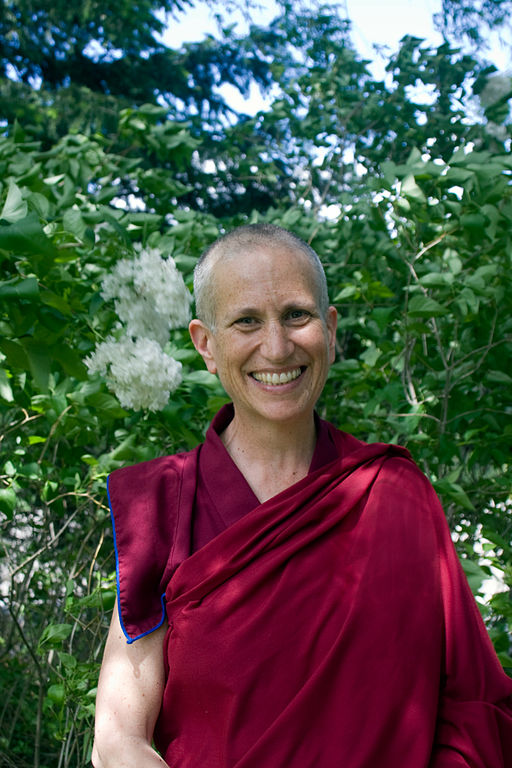 Thubten Chodron (born 1950)
Thubten Chodron (born 1950)
Thubten Chodron, born Cheryl Greene, is an American Tibetan Buddhist nun, author, teacher, and the founder and abbess of Sravasti Abbey. Chodron is a central figure in the reinstatement of the Bhikshuni (Tibetan: Gelongma) ordination of women. Born in 1950, Bhikshuni Thubten Chodron grew up in a "non-religious Jewish" family near Los Angeles, California and earned her B.A. in history from UCLA in 1971. After traveling through Europe, North Africa and Asia for one and a half years, she attended a meditation course in 1975, and subsequently went to Kopan Monastery in Nepal to continue studying Buddhism. In 1977 she was ordained as a Buddhist nun by Kyabje Ling Rinpoche in Dharamshala, and in 1986 she received bhikshuni (full) ordination in Taiwan. Chodron has studied and practiced Buddhism in the Tibetan tradition extensively in India and Nepal under the guidance of the 14th Dalai Lama, Tsenzhab Serkong Rinpoche, Lama Thubten Yeshe, Thubten Zopa Rinpoche and other Tibetan masters and for three years at Dorje Pamo Monastery in France. She directed the spiritual program at Istituto Lama Tzong Khapa in Italy for nearly two years, was resident teacher at Amitabha Buddhist Centre in Singapore, and for 10 years was spiritual director and resident teacher at Dharma Friendship Foundation in Seattle, US. Emphasizing the practical application of the Buddha’s teachings in our daily lives, Thubten Chodron tries to explain them in ways easily understood and practised by Westerners. She has worked on re-establishing the Bhikshuni lineage of Buddhist nuns, cultivating interfaith dialogue, and Dharma outreach in prisons. Seeing the importance and necessity of a monastery for Westerners training in the Tibetan Buddhist tradition, she founded Sravasti Abbey, a Buddhist monastic community north of Spokane, WA and is the abbess there. It is the only Tibetan Buddhist training monastery for Western monks and nuns in America. Thubten Chodron is also author or editor of more than 25 books on Buddhism, including two works co-written with the 14th Dalai Lama.
Left: Thubten Chodron photographed on the grounds of Sravasti Abbey. Text source: Wikipedia (edited). This version of Wikipedia content is published here under a Creative Commons Attribution-ShareAlike 3.0 Unported License. Image source: Wikimedia Commons. Image author: Sravasti Abbey. Image license: Public domain. All books in the gallery immediately below are by Chodron unless otherwise noted.
Lama Surya Das (born 1950)
An American lama in the Tibetan Buddhist tradition, poet, chantmaster, spiritual activist, author of many popular works on Buddhism, meditation teacher, and spokesperson for Buddhism in the West. He has long been involved in charitable relief projects in the Third World and in interfaith dialogue. Surya Das is a Dharma heir of Nyoshul Khenpo Rinpoche, a Nyingma master of the non-sectarian Rime movement, with whom he founded the Dzogchen Center and began leading Dzogchen retreats in 1991. Surya Das was born Jeffrey Miller and raised in Valley Stream, Long Island, New York. He attended the State University of New York at Buffalo, graduating with honors in 1971, with a degree in Creative Education. After his best friend's girlfriend, Allison Krause, was killed during the Kent State shootings, Surya Das began pursuing spirituality. From 1971 to 1976 he traveled in India. There he studied Hinduism with Neem Karoli Baba as well as Vipassana with S.N. Goenka and Anagarika Munindra, of the Theravada tradition. His name, which means "Servant of the Sun" in a combination of Sanskrit (sūrya) and Hindi (das, from the Sanskrit dāsa), was given to him in 1972 by the Hindu guru Neem Karoli Baba. In 1973 and 1974, he lived in Kyoto, Japan, where he taught English and studied Zen Buddhism under Uchiyama Roshi. During his travels in India and Nepal, Das studied with Tibetan Buddhist Lamas Thubten Yeshe, Kalu Rinpoche, The 16th Gyalwa Karmapa, Tulku Urgyen, Thrangu Rinpoche, Dezhung Rinpoche, Dilgo Khyentse, and Kangyur Rinpoche. He resided at the newly established Karma Triyana Dharmachakra monastery in Woodstock, New York from 1977 to 1980. Surya Das attended the first Nyingmapa retreat center in Dordogne, France in 1980. At the center, he completed two Dzogchen three-and-a-half-year retreats under the guidance of Dudjom Rinpoche and Dilgo Khyentse Rinpoche. He was empowered to teach in 1984. He has worked with the Dalai Lama since the early 1990s on a variety of projects. That included organizing several weeklong International Buddhist Teachers Conferences with the Dalai Lama in Dharamsala, India, and America. He also founded the Western Buddhist Teachers Network. In 1991, Surya Das returned from his two decades at Tibetan monasteries and retreats to establish the Dzogchen Foundation and Centers to help further the spread of Tibetan Buddhism in the West. According to the Foundation, Dzogchen introduces and unveils the "innate spiritual intelligence or intrinsic awakefulness" in practitioners. Surya Das has said, "It is the perfect nature of all things."
Text source: Wikipedia (edited). This version of Wikipedia content is published here under a Creative Commons Attribution-ShareAlike 3.0 Unported License. All books in the gallery immediately below are by Lama Surya Das.
 Geshe Tashi Tsering (born 1958)
Geshe Tashi Tsering (born 1958)
A Tibetan Buddhist monk and teacher who serves as abbot of Sera Mey Monastic University in India. From 1994 to 2018, he was the resident Tibetan Buddhist teacher at Jamyang Buddhist Centre, London. Tsering was born in Purang, Tibet in 1958, and his parents escaped to India in 1959. He entered Sera Mey Monastic University in South India when he was 13 years old, and graduated with a Lharampa Geshe degree 16 years later. Geshe Tashi then entered the Higher Tantric College (Gyuto) for a year of study. Tsering's teaching career began at Sera, after which he taught the monks at Kopan Monastery, Nepal for a year. He went on to the Gandhi Foundation College in Nagpur, India and then moved to Europe, initially to Nalanda Monastery in the South of France. In the west, Tsering teaches in English and is renowned for his warmth, clarity and humour. Besides Jamyang, he has been a regular guest teacher at other Buddhist centres in the UK and around the world. In March 2018 it was announced that Geshe Tashi Tsering had been asked by the Dalai Lama to become abbot of Sera Mey Monastic University. He was enthroned as abbot on 17 June 2018. In June 2019 he was awarded the British Empire Medal in the Queen's birthday honours list for services to Buddhism in the UK.
Left: A portrait of Geshe Tsering. Image source: Wikimedia Commons. Image author: Lobsang Sherap. Image license: Public domain. Text source: Wikipedia (edited). This version of Wikipedia content is published here under a Creative Commons Attribution-ShareAlike 3.0 Unported License. All books in the gallery immediately below are by Geshe Tsering.

Above: An assembly hall at Drepung Monastery, which is one of the "great three" Gelug university gompas (monasteries) of Tibet along with Ganden Monastery and Sera Monastery.
Text source: Wikipedia (edited). This version of Wikipedia content is published here under a Creative Commons Attribution-ShareAlike 3.0 Unported License. Image source: Flickr. Image author: KL.Lau. Image license: Creative Commons Attribution-NonCommercial-NoDerivs 2.0 Generic.



























































































































































